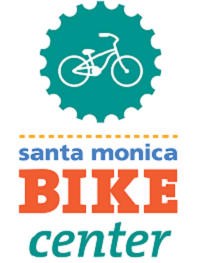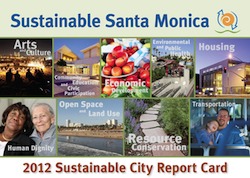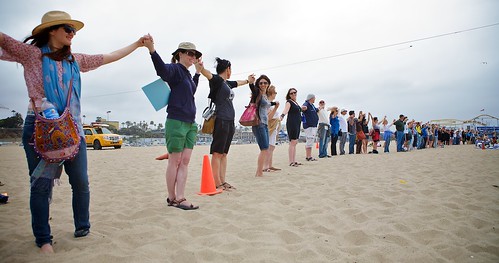One of the ways I’m often reminded I’m really a Santa Monican first, Angeleno second, is when I see Styrofoam as a food container . It makes feel a little ill inside. We pride ourselves on environmental stewardship as a core value in Santa Monica, and take protecting the coast and the ocean seriously. Always striving to get items that will not breakdown out of our waste stream and off the beaches. However there is much more we can and must do if we truly want to lead on a society wide transition to sustainability and a stabilized impact on the natural world that supports our very existence.
I want to take a moment here to step back and be more specific about what is meant by sustainable, especially since the word is so often overused, and subject to abuse. Jarret Walker of Human Transit has on occasion called for another word, pointing jokingly to the unsustainbility of the word sustainability, and his own preference for durable. Durable being the word the french use for sustainability. Resilience is also a term gaining a lot of traction recently as well, with it's own slightly differing connotations.
However any word can be warped of concrete meaning if we let people get away with sliding definitions or dubious contexts. I often wished we spent as much effort trying to defend and articulate the meaning of the words we use as we did trying to imagine or adopt new ones after letting others be appropriated or co-opted.
I recently read The Natural Step A Framework for Sustainability, a short book from The Schumacher Briefings series, summarizing the organization and framework for sustainability called The Natural Step (or TNS). The book caught my eye recently in one of the displays at the library. Every since I read about this brief it has really stuck with me as a potentially valuable tool. Whether we stick with the word sustainability or adopt another word to try and encapsulate the concept, the TNS principles are worth considering as a starting point.
Santa Monica is a city which has had sustainability as a deliberate area of focus since at least the passage of the 1994 Sustainable City Plan (SCP). A component of this effort includes an annual report grading progress on a range of fronts by the city's Office of Sustainability. Progress has been better on some fronts more than others, but there are some well articulated & worthy guiding principles in these documents that reflect a local consensus that has been tweaked overtime to build on the original ideas. Unbeknownst to myself until doing some more research for this column, the Santa Monica SCP was directly influenced by the TNS framework and is featured on the TNS website along with suggestions for areas to focus on improvement toward meeting the goals (as of a now outdated 2002 case study).
At the core of TNS is the following 4 system conditions and related principles in the chart below, which are rooted in ecological and physical sciences. This framework was originally crafted by Dr. Karl-Henrik Robèrt, a Swedish cancer scientist who became interested in environmental factors & issues, & his ideas facilitated a number of major successes toward sustainability in Swedish governments and private businesses. The first 3 conditions are checks against the systemically increasing degradation of natural systems, and the 4th condition ensures that human needs must not be deprived or undermined.
That 4th condition and principle is there for very human ethical reasons, but also because achieving the first 3 can be undermined if human needs are not met in the process. A recent example of the connection that can exist between human needs and environmental stability that caught my attention is the sudden poverty that has struck many in the economic turmoil and austerity measures imposed on Greece. In Athens, where unemployment now runs incredibly high, some who cannot afford utility costs any longer are now burning wood to keep warm as other heating has become unaffordable. This resulted in increased local emissions and threatened tree stocks in the winter months as the economic situation took its human toll.
| In a sustainable society, nature is not subject to systematically increasing: | To become a sustainable society we must… |
| 1. concentrations of substances extracted from the earth’s crust | 1. eliminate our contribution to the progressive buildup of substances extracted from the Earth’s crust (for example, heavy metals and fossil fuels) |
| 2. concentrations of substances produced by society | 2. eliminate our contribution to the progressive buildup of chemicals and compounds produced by society (for example, dioxins, PCBs, and DDT) |
| 3. degradation by physical means | 3. eliminate our contribution to the progressive physical degradation and destruction of nature and natural processes (for example, over harvesting forests and paving over critical wildlife habitat); and |
| 4. and, in that society, people are not subject to conditions that systemically undermine their capacity to meet their needs | 4. conditions that systematically undermine people’s capacity to meet their basic human needs (for example, unsafe working conditions and not enough pay to live on). |
This TNS definition of sustainability using 4 conditions and elaborated principles, complements the Brundtland Commission definition of sustainable development from 1987: “Sustainable development seeks to meet the needs and aspirations of the present without compromising the ability to meet those of the future”.
Thinking through the application of these principles to systems of any scale, from the production of a particular product, to the function of entire cities, results in a tense balancing act. If we make progress on one or two of the principles and in the process of doing so make one or two of the others progressively worse, such a progression is not truly viable. The TNS organization refers to a sustainability nexus to strive toward, an eventual outcome that complies fully with all four principles, & they promote the use of backcasting to try and get there. Backcasting is used to imagine sustainable outcomes & work backward rather than start from our existing systems & carry them forward as is typically done in forecasting.
This framework does not imply that we cannot use natural resources, even substances and resources extracted from the crust outlined in the first principle. It's that systematically increasing accumulation of byproducts into natural systems and growing degradation, that are overwhelming the capacity for natural systems to recover from our actions and collectively growing footprint.
The word sustainable gets tossed around a lot these days, especially in Santa Monica, but I'd like to challenge us as a community to ensure that always really means something. We can't simply let the marketers who latch onto any perceived buzzword go and obscure the goal posts, and the very real science that defines them, for their own ends.
Perhaps more troubling, is watching conspiracies ignited by astroturf campaigns run wild & spread unfounded ideas of what sustainability and sustainable development means. Although the impact of such campaigning has done little to change broad public opinion, it has resulted in some pointed attacks from certain political corners. Such as the truly bizarre piece of legislation, HB 2366, introduced in Kansas recently that would ban any public funds from being used "directly or indirectly, to promote, support, mandate, require, order, incentivize, advocate, plan for, participate in or implement sustainable development," either by the state or even any local municipality.
Huh? Adding further confusion the bill also includes a list of certain ideas allowed to be promoted by the state, that features the related but distinct concept of conservation.
Whatever we call the principles needed to ensure our enduring existence on this planet and future prosperity; be it sustainability, resiliency, durability, or something else altogether, we do have to fight for the meaning of our words. If we don't, we may just watch those very words start working against our admirable and necessary ambitions.










